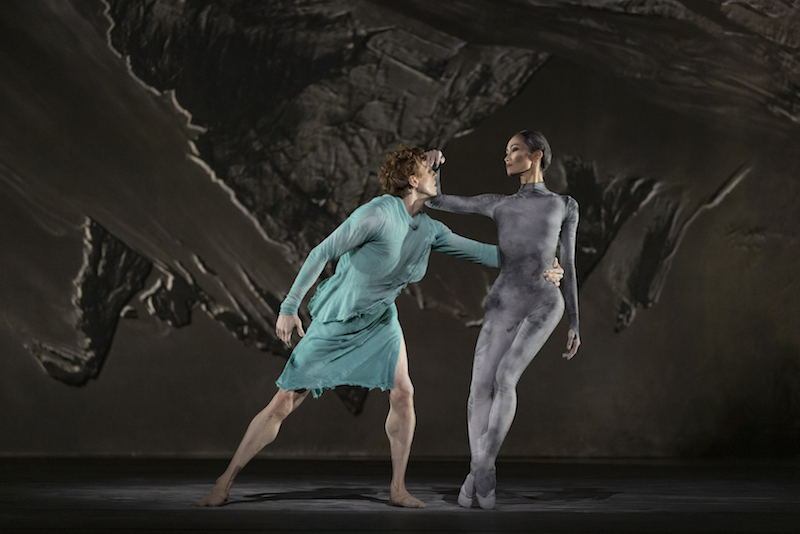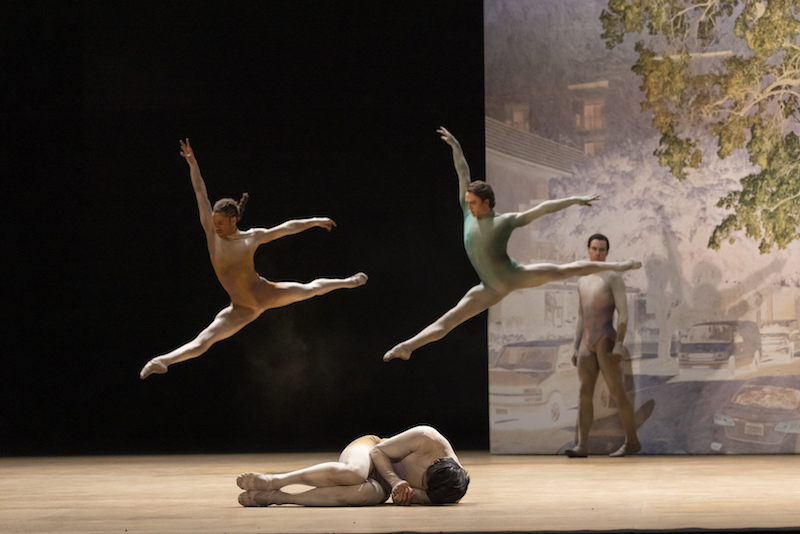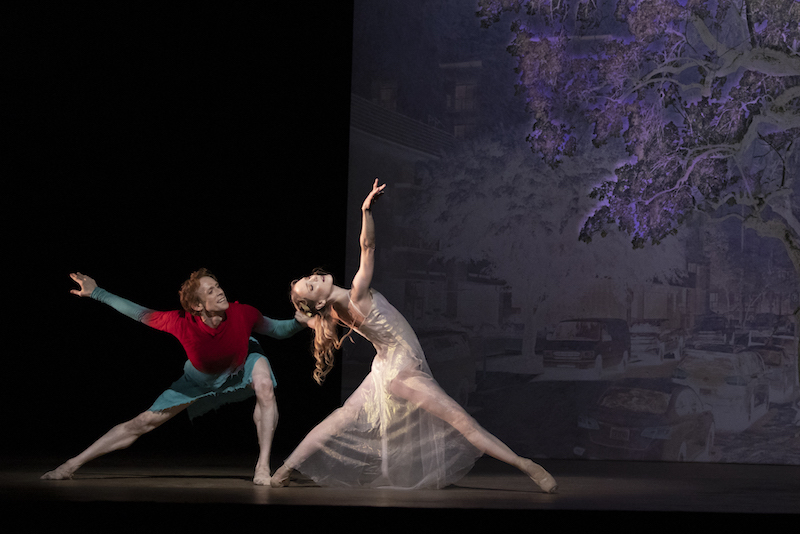The Dante Project, Royal Ballet review - a towering achievement | reviews, news & interviews
The Dante Project, Royal Ballet review - a towering achievement
The Dante Project, Royal Ballet review - a towering achievement
A stupendous score by Thomas Adès powers this inspiring undertaking

Unless you happen to be a student of Italian language or culture, the significance of the 14th-century poet Dante Alighieri’s insights into the human condition may have passed you by, albeit that this year marks 700 years since his death. Where every educated Italian knows the stories and characters within La divina commedia like the back of their hand, we British generally draw a blank.
And yet to a great extent they do. Granted, the programme booklet is fat with helpful essays, quotations from the poetry and detailed breakdowns of the production’s three acts – Inferno, Purgatorio and Paradiso – but there’s no time to read more than a fraction of it before curtain-up. The hope must be that audiences, wowed by the sensory blast of this extraordinary offering in sight and sound, will return for the detail they missed, as I’m planning to do. The wow-factor registers in the first moments of Adès’ score, plunging the listener into a crater of downward-spiralling sound. It doesn’t let you in gently, this music – it’s flat-out hellish, much in the manner of Liszt’s Dante Sonata whose material, along with Liszt’s Dante Symphony, supplies grist to Adès’ mill, not always in the form of direct quotation. Plummeting glissandi – often from the bass trombones – deliver a vertiginous sense of tumbling into a chasm. And that doom is reflected, literally, in Tacita Dean’s backcloth, a craggy mountain range chalked on blackboard and given 3D presence by Lucy Carter's lighting. A circular mirror embedded within it offers an overhead reminder to the cavorting damned souls of their earthly sin. I understand the stage floor was reflective too, if your seat was in a position to see it. Grumbles overheard at the first interval of restricted views of other elements need to be set in context: there is so much to see and hear in this piece that even with an optimum view you would struggle to take it all in. This is not a criticism. A world as densely imagined as Dante’s deserves a response in kind.
The wow-factor registers in the first moments of Adès’ score, plunging the listener into a crater of downward-spiralling sound. It doesn’t let you in gently, this music – it’s flat-out hellish, much in the manner of Liszt’s Dante Sonata whose material, along with Liszt’s Dante Symphony, supplies grist to Adès’ mill, not always in the form of direct quotation. Plummeting glissandi – often from the bass trombones – deliver a vertiginous sense of tumbling into a chasm. And that doom is reflected, literally, in Tacita Dean’s backcloth, a craggy mountain range chalked on blackboard and given 3D presence by Lucy Carter's lighting. A circular mirror embedded within it offers an overhead reminder to the cavorting damned souls of their earthly sin. I understand the stage floor was reflective too, if your seat was in a position to see it. Grumbles overheard at the first interval of restricted views of other elements need to be set in context: there is so much to see and hear in this piece that even with an optimum view you would struggle to take it all in. This is not a criticism. A world as densely imagined as Dante’s deserves a response in kind.
Choreographically, MacGregor clearly had fun depicting Hell’s swarms of sinners: adulterous lovers, gluttons, hypocrites and thieves, plus a brief cameo for Satan himself (pictured with Dante above), interestingly cast as female. Alluring Fumi Kaneko is clad – like all the other damned souls – in chalk-sprayed black Lycra. But while I would like to be able to report on the ingenious solutions MacGregor finds to the challenges of, say, depicting lovers buffeted by wind, or a body with two heads, these details passed me by. The hellish murk made it hard to distinguish the features of even half the 13 vignettes listed in the programme. The idea of chalking the body parts that actioned the sin (the thieves’ hands, the adulterers’ loins) is clever in principle, but across the great distances of the Opera House didn’t register strongly enough. That can be fixed. Purgatory – as every good Catholic knows – is another country, one where repentant sinners are given a chance to reflect. Here, against Tacita Dean’s calming giant photograph of a jacaranda tree growing on an LA kerbside (pictured above), it’s easier to tell what’s going on. Having been led through Hell by Gary Avis’s Virgil, a patient tour guide, Edward Watson’s Dante is left to reflect on his own life, not least on his childhood love for Beatrice (Sarah Lamb, pictured below with Watson). Cue a sequence of blithe and lovely duets for two sets of dancers representing the pair as children and then as adolescents (with Francesca Hayward at her most felicitous). Meanwhile, the musical score takes an astonishing handbrake turn as a grizzled male voice intones ancient religious song, recorded in a synagogue in Syria, its twining levantine melody later hauntingly adopted by the orchestra.
Purgatory – as every good Catholic knows – is another country, one where repentant sinners are given a chance to reflect. Here, against Tacita Dean’s calming giant photograph of a jacaranda tree growing on an LA kerbside (pictured above), it’s easier to tell what’s going on. Having been led through Hell by Gary Avis’s Virgil, a patient tour guide, Edward Watson’s Dante is left to reflect on his own life, not least on his childhood love for Beatrice (Sarah Lamb, pictured below with Watson). Cue a sequence of blithe and lovely duets for two sets of dancers representing the pair as children and then as adolescents (with Francesca Hayward at her most felicitous). Meanwhile, the musical score takes an astonishing handbrake turn as a grizzled male voice intones ancient religious song, recorded in a synagogue in Syria, its twining levantine melody later hauntingly adopted by the orchestra. Just as the Inferno of Act I was chaotic and dark, the third and final Act in Paradise is all simplicity and light, the dancers’ Lycra’d bodies shining silvery white. Adès resumes his musical spirals, only now they spiral skyward, piccolos ascending to their highest register like over-excited larks. He also homes in on Prokofiev, fragmenting the loved-up balcony music in Romeo and Juliet and playing with the shards with breathtaking virtuosity. Above the stage Dean’s design distils to a projected glowing coloured sphere like an all-seeing eye or blazing sun, while Carter's lighting turns dancers' bodies into heavenly beings. This is the eternal light that, in the poem, Dante finds he cannot look at, until Beatrice persuades him he can. At last the ballet reveals her in her full beauty, Sarah Lamb swooping and diving in a gauzy pale gold blur while female voices from the London Symphony chorus add to a final ecstatic crescendo.
Just as the Inferno of Act I was chaotic and dark, the third and final Act in Paradise is all simplicity and light, the dancers’ Lycra’d bodies shining silvery white. Adès resumes his musical spirals, only now they spiral skyward, piccolos ascending to their highest register like over-excited larks. He also homes in on Prokofiev, fragmenting the loved-up balcony music in Romeo and Juliet and playing with the shards with breathtaking virtuosity. Above the stage Dean’s design distils to a projected glowing coloured sphere like an all-seeing eye or blazing sun, while Carter's lighting turns dancers' bodies into heavenly beings. This is the eternal light that, in the poem, Dante finds he cannot look at, until Beatrice persuades him he can. At last the ballet reveals her in her full beauty, Sarah Lamb swooping and diving in a gauzy pale gold blur while female voices from the London Symphony chorus add to a final ecstatic crescendo.
Originally intended to premiere in May 2020, Wayne MacGregor's vast project has attained fresh layers of allegory during the wait. Covid brought hell to earth for some, and it could be said that all of us have gone through a period of purgatory, of stasis, self-questioning, not knowing what lies ahead. If the ambition of The Dante Project is admirable, its achievement is inspirational, despite the minor flaws. So what if it feels like a glorious orchestral concert (with a serious claim to being the greatest music composed this century) cum art show, a high-class son-et-lumière? The choreography won't be the thing you go home humming, but the whole experience is to die for.
rating
Explore topics
Share this article
Add comment
The future of Arts Journalism
You can stop theartsdesk.com closing!
We urgently need financing to survive. Our fundraising drive has thus far raised £49,000 but we need to reach £100,000 or we will be forced to close. Please contribute here: https://gofund.me/c3f6033d
And if you can forward this information to anyone who might assist, we’d be grateful.

Subscribe to theartsdesk.com
Thank you for continuing to read our work on theartsdesk.com. For unlimited access to every article in its entirety, including our archive of more than 15,000 pieces, we're asking for £5 per month or £40 per year. We feel it's a very good deal, and hope you do too.
To take a subscription now simply click here.
And if you're looking for that extra gift for a friend or family member, why not treat them to a theartsdesk.com gift subscription?
more Dance
 'We are bowled over!' Thank you for your messages of love and support
Much-appreciated words of commendation from readers and the cultural community
'We are bowled over!' Thank you for your messages of love and support
Much-appreciated words of commendation from readers and the cultural community
 R:Evolution, English National Ballet, Sadler's Wells review - a vibrant survey of ballet in four acts
ENB set the bar high with this mixed bill, but they meet its challenges thrillingly
R:Evolution, English National Ballet, Sadler's Wells review - a vibrant survey of ballet in four acts
ENB set the bar high with this mixed bill, but they meet its challenges thrillingly
 Like Water for Chocolate, Royal Ballet review - splendid dancing and sets, but there's too much plot
Christopher Wheeldon's version looks great but is too muddling to connect with fully
Like Water for Chocolate, Royal Ballet review - splendid dancing and sets, but there's too much plot
Christopher Wheeldon's version looks great but is too muddling to connect with fully
 iD-Reloaded, Cirque Éloize, Marlowe Theatre, Canterbury review - attitude, energy and invention
A riotous blend of urban dance music, hip hop and contemporary circus
iD-Reloaded, Cirque Éloize, Marlowe Theatre, Canterbury review - attitude, energy and invention
A riotous blend of urban dance music, hip hop and contemporary circus
 How to be a Dancer in 72,000 Easy Lessons, Teaċ Daṁsa review - a riveting account of a life in dance
Michael Keegan-Dolan's unique hybrid of physical theatre and comic monologue
How to be a Dancer in 72,000 Easy Lessons, Teaċ Daṁsa review - a riveting account of a life in dance
Michael Keegan-Dolan's unique hybrid of physical theatre and comic monologue
 A Single Man, Linbury Theatre review - an anatomy of melancholy, with breaks in the clouds
Ed Watson and Jonathan Goddard are extraordinary in Jonathan Watkins' dance theatre adaptation of Isherwood's novel
A Single Man, Linbury Theatre review - an anatomy of melancholy, with breaks in the clouds
Ed Watson and Jonathan Goddard are extraordinary in Jonathan Watkins' dance theatre adaptation of Isherwood's novel
 Peaky Blinders: The Redemption of Thomas Shelby, Rambert, Sadler's Wells review - exciting dancing, if you can see it
Six TV series reduced to 100 minutes' dance time doesn't quite compute
Peaky Blinders: The Redemption of Thomas Shelby, Rambert, Sadler's Wells review - exciting dancing, if you can see it
Six TV series reduced to 100 minutes' dance time doesn't quite compute
 Giselle, National Ballet of Japan review - return of a classic, refreshed and impeccably danced
First visit by Miyako Yoshida's company leaves you wanting more
Giselle, National Ballet of Japan review - return of a classic, refreshed and impeccably danced
First visit by Miyako Yoshida's company leaves you wanting more
 Quadrophenia, Sadler's Wells review - missed opportunity to give new stage life to a Who classic
The brilliant cast need a tighter score and a stronger narrative
Quadrophenia, Sadler's Wells review - missed opportunity to give new stage life to a Who classic
The brilliant cast need a tighter score and a stronger narrative
 The Midnight Bell, Sadler's Wells review - a first reprise for one of Matthew Bourne's most compelling shows to date
The after-hours lives of the sad and lonely are drawn with compassion, originality and skill
The Midnight Bell, Sadler's Wells review - a first reprise for one of Matthew Bourne's most compelling shows to date
The after-hours lives of the sad and lonely are drawn with compassion, originality and skill
 Ballet to Broadway: Wheeldon Works, Royal Ballet review - the impressive range and reach of Christopher Wheeldon's craft
The title says it: as dancemaker, as creative magnet, the man clearly works his socks off
Ballet to Broadway: Wheeldon Works, Royal Ballet review - the impressive range and reach of Christopher Wheeldon's craft
The title says it: as dancemaker, as creative magnet, the man clearly works his socks off
 The Forsythe Programme, English National Ballet review - brains, beauty and bravura
Once again the veteran choreographer and maverick William Forsythe raises ENB's game
The Forsythe Programme, English National Ballet review - brains, beauty and bravura
Once again the veteran choreographer and maverick William Forsythe raises ENB's game

Comments
Times please fact check! The